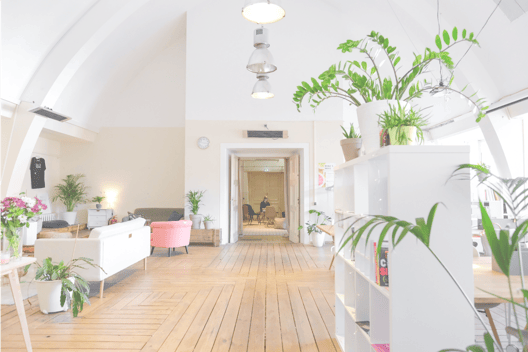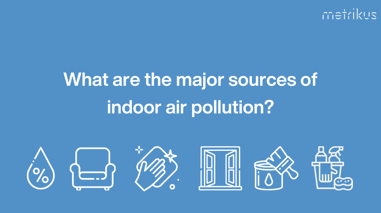Top tips on improving building air quality
April 27, 2020
Air pollution is recognised by the World Health Organisation as the greatest environmental threat to global health. Let’s take a look at the hard facts about air quality:
In recent years, outdoor air quality has started to receive the much-needed attention it demands. However, indoor air quality remains overlooked. Given that levels of indoor air pollutants are often 2 to 5 times higher than outdoor levels, this should be alarming. Even before lockdown, we were spending over 90% of our time indoors: in the face of lockdown restrictions, this is closer to 100% for many of us.
Here we take a look into how we can make buildings healthier, during this global health crises and beyond.
The COVID-19 pandemic
The COVID-19 pandemic has undoubtedly accentuated the need for healthier indoor air. There have been many studies confirming that air quality has a direct correlation with COVID-19.
Transmission
Viruses can be transmitted via the air through either close contact transmission through large droplets (bigger than 10 microns), or through airborne transmission through small particles (smaller than 5 microns). These small virus particles may stay airborne for hours and can be transported long distances, carried by airflows in rooms or the extraction air ducts of ventilation systems.
The American Society of Heating, Refrigerating and Air-Conditioning Engineers (ASHRAE) has stated that transmission of COVID-19 ‘through the air is sufficiently likely that airborne exposure to the virus should be controlled’. This can be achieved, they say, via ‘changes to building operations, including the operation of heating, ventilating, and air-conditioning systems’.
Furthermore, the Building Engineers Services Association (BESA) has advised that clean air technologies and strategies should be adopted by every healthcare facility in the UK in the wake of COVID-19. It is clearly even more essential than ever for steps to be taken to improve the air quality inside buildings.
Air quality and COVID-19
Recent studies have confirmed the link between poor air quality and the infection and survival rates from COVID-19. A Harvard study led by Professor Francesca Dominici along with Doctoral student Xiao Wu and Assistant Professor Rachel Nethery showed the link between long-term exposure to PM2.5 and the mortality rate of COVID-19. Their research found that a one unit increase in long-term average exposure to fine particulate matter was associated with a 15% increase in COVID-19 mortality rate on average.
Furthermore, a study by Yaron Ogen from the Martin Luther University of Halle-Wittenberg in Germany found that NO2 is also linked to higher COVID-19 death rates. Ogen looked at satellite data to map the distribution of NO2 across Europe in the months leading up to the pandemic, and charted the number of COVID-19 deaths from 66 regions in Spain, Italy, France and Germany. Results showed that out of the 4,443 fatality cases, 3,487 (78%) were in five regions located in north Italy and central Spain: those with the highest NO2 concentrations.
Transmission of viruses in buildings can also be limited by changing air temperatures and humidity levels. Research to date suggests that COVID-19 is fairly resistant to environmental changes and is only affected at a high relative humidity above 80% and a temperature above 30 degrees.
However, it’s not as simple as increasing humidity: on the other side of the spectrum, low humidity can cause mucous membranes to dry out, which compromises our body’s natural defense to viruses.
Increasing ventilation for better air quality
The ventilation industry will have a pivotal role to play in making buildings safe, particularly when we begin to emerge from lockdown. Future buildings will need considerably improved ventilation systems to tackle cross-contamination and air distribution. To make current buildings safer, increasing ventilation is a vital step to reduce the risk of airborne transmission.
The general advice is to supply as much outside air as reasonably possible, in order to increase the amount of fresh air supplied per person. This can be achieved by keeping ventilation running for longer periods of time, or keeping it on constantly, but at a lower rate when people are absent.
Ventilation is also enhanced by maintaining sufficient spacing between occupants. When employees return to their offices, it will be important that they remain spread out and are not confined in small areas for long periods of time, as this could lead to inadequate ventilation. Where possible, opening windows is another effective way of boosting air exchange rates.
It is also advisable for decentralised systems such as fan coil units that use local recirculation to be turned off, to avoid resuspension of virus particles at room level. If it is not possible for these systems to be turned off, they must be cleaned regularly.
Installing air purification systems
Whilst ventilation systems are important in order to increase air supply, they do not typically clean or purify the air inside a building, and leave harmful substances and toxic pathogens in the air. Even the best HVAC system cannot completely prevent the transmission of COVID-19 by droplets or aerosols, meaning that localised air purification is crucial to maintaining a healthy environment.
Unfortunately, many air purifiers are not particularly efficient. To be effective, they must have HEPA filter efficiency. These filters can capture particles within the size range of COVID-19. The right type of air purification technology can be extremely effective in removing pathogens from the air, making it cleaner and healthier.
Real-time monitoring
The benefits of real-time indoor air quality monitoring in this scenario are limitless. Some aspects that can be monitored include:
-
temperature
-
humidity
-
CO2 (carbon dioxide)
-
CO (carbon monoxide)
-
NO2 (nitrogen dioxide)
-
O3 (atmospheric ozone)
-
VOCs (volatile organic compounds)
-
PM2.5 (fine particulate matter)
By implementing sensors, you can ensure that these parameters stay within optimal levels.
While COVID-19 is currently the most pressing concern, ongoing air quality monitoring can also prevent Sick Building Syndrome and optimise occupant wellbeing. Smart alerts can be set up to notify your Facility Team when environmental parameters deviate from their optimal zone, and remedial action can be taken via your building management system (BMS) where appropriate. For example, ventilation can be increased to improve your air quality and create a healthier environment for occupants.
The bottom line
Poor indoor air quality can no longer be ignored. It is vital for steps to be taken to make buildings safer for occupants, including improving ventilation, implementing air purification technology, and undertaking real-time monitoring of key parameters. Perhaps one positive outcome of this devastating pandemic will be that we pay more attention to one of the biggest ongoing health threats we face: poor indoor air quality.




